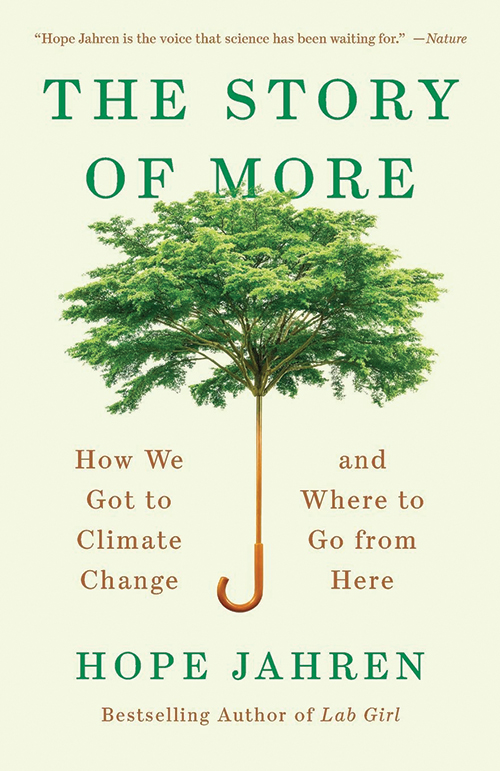
The Story of More: How We Got to Climate Change and Where to Go from Here
Reviewed by Philip Favero
November 1, 2020
By Hope Jahren. Vintage Books, 2020. 224 pages. $15/paperback; $11.99/eBook.
As readers of Hope Jahren’s previous bestselling book Lab Girl know, she has a talent for teaching science by telling stories. In The Story of More, Jahren tells how, since her birth in 1969, humans have doubled in population (adding nearly four billion people to our planet) and how those of us who live in richer nations have increased our consumption and our waste. We have thereby applied pressure on the earth’s productive capacity, and required the invention of new technologies to feed ourselves and to energize our homes, factories, and travel. Much of the energy for growth has been generated by burning fossil fuels—coal, oil, and natural gas—which is adding alarmingly high levels of carbon dioxide (CO2) to the Earth’s atmosphere, thereby trapping the sun’s heat on the planet. By heating the earth, we are producing a mass extinction event and endangering the well-being, indeed the existence, of our own species.
Jahren argues that the key challenge we now face—a challenge she believes we can meet—is to reduce the world’s uneven distribution of the earth’s resources. Individuals living in richer countries—especially those in the United States—can significantly reduce the world’s CO2 emissions by (1) diminishing levels of personal consumption, (2) wasting less, and (3) purchasing goods and services that require less carbon for their production. Jahren provides a menu of individual practices and asks readers to check their personal values and commit to an action. She argues that undertaking new individual private practices is the necessary precursor to taking collective public actions.
What, however, will motivate people to adopt practices for a fairer distribution of the world’s resources and to sustain those efforts over time? The author does not address this question directly, but in the acknowledgments section she opens the door for a spiritual, including a Quaker, answer. Written in Oslo, where Jahren teaches, the acknowledgments read:
Last but not least, I want to thank whoever graffitied the electrical box at the corner of Blindernveien and Apalveien with: “We worship an invisible god and slaughter a visible nature—without realizing that this nature we slaughter is the invisible god we worship.” It got me to thinking.
Viewing nature as being soaked with the Divine but abused by humans is key to changing the story we tell ourselves about our role and responsibility in caring for the earth. The old story based on unlimited economic growth; exploitation of nature; and domination of Indigenous peoples, immigrants, people of color, and those of lower economic status is not working. That story is leading to economic inequality, political instability, and ecological catastrophe. The old story is being defended and protected, of course, by those who profit from it and by people drawn to illusions about making things great again. A new story is needed to address complex, moral, global problems, including how to motivate and sustain practices and policies to halt and reduce fossil carbon pollution of the atmosphere. New story thinking is found in the works of Thomas Berry, Brian Swimme, Mary Evelyn Tucker, and others.
Quakers, as informed by the New Story Group at Friends Meeting at Cambridge (Mass.) and organized by Quaker Earthcare Witness, are involved in furthering new story ideas; see, for example: Mary Conrow Coelho’s Awakening Universe, Emerging Personhood (2002) and her Recovering Sacred Presence in a Disenchanted World (Pendle Hill pamphlet #433, 2015); the New Story Group webpage (fmcquaker.org/outreach/new-story); and Quaker Earthcare Witness’s website (quakerearthcare.org/article/quakers-and-new-story).
A seemingly simple but significant change to strengthen new story thinking among Friends (a change being discussed in my monthly meeting of Agate Passage, Wash.) would be to broaden the Quaker testimony of equality. Instead of referencing humans only, it would become “There is that of the Divine in all of nature.” That change would imply an expansion of the testimony of community to include the following insight about relationships: We live in a universe that is a community of subjects, not a collection of objects. Humans are interdependent with nature and should become part of its creative evolution. In other words, we are to be responsible agents for protecting our planet and the life she hosts. In new story thinking, our mission is to aid the Earth’s evolutionary movement toward truth, beauty, and goodness (love). Such changes in our testimonies would serve to motivate and sustain urgent efforts among Friends to oppose climate change and the mass extinction event that humans now face.
Philip Favero resides on Bainbridge Island, Wash. He is a member of Agate Passage Meeting in Kingston, Wash., and the Social and Environmental Justice Working Group.


